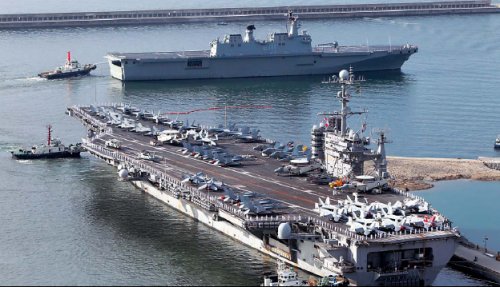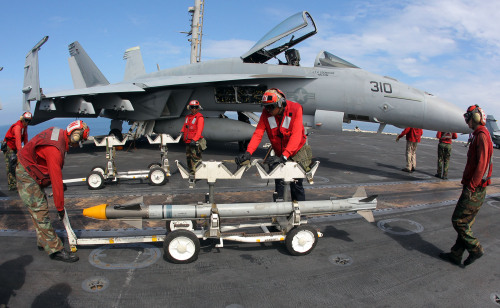NDC Threatens Invincible Spirit With “Sacred War”

The U.S. aircraft carrier USS George Washington and South Korea’s amphibious landing ship Dokdo depart from a naval base in Busan to participate in a joint military exercise in the East Sea on Sunday. (Yonhap)
The National Defense Commission targeted a bit of strategic invective against Invincible Spirit, joint ROK-US military exercises being held in response to the March sinking of the Cheonan.
The army and people of the DPRK will legitimately counter with their powerful nuclear deterrence the largest-ever nuclear war exercises to be staged by the U.S. and the south Korean puppet forces.
The more desperately the U.S. imperialists brandish their nukes and the more zealously their lackeys follow them, the more rapidly the DPRK’s nuclear deterrence will be bolstered up along the orbit of self-defence and the more remote the prospect for the denuclearization of the Korean Peninsula will be become.
The army and people of the DPRK will start a retaliatory sacred war of their own style based on nuclear deterrent any time necessary in order to counter the U.S. imperialists and the south Korean puppet forces deliberately pushing the situation to the brink of a war.
Now that the U.S. imperialists are persisting in their direct military provocations in gross violation of the spirit of the September 19 joint statement in which they promised not to attack or invade the DPRK with either nuclear or conventional weapons, it is a natural option of the army and people of the DPRK to take corresponding all-out retaliatory measures.
Yonhap reports on the second of Invincible Spirit’s four days of exercises:
South Korea and the U.S. plan to hold anti-submarine exercises Monday during their second day of large-scale joint military drills in the East Sea, officials said.
Led by U.S. aircraft carrier, the USS George Washington, about 20 ships, 200 aircraft and 8,000 military personnel from the two allies are staging the four-day naval and air readiness exercises from Sunday in a show of force against North Korea for its sinking of a South Korean warship.
“Today, we plan to conduct exercises aimed at better detecting intrusions by an enemy’s submarines and attacking them,” said an official for the South’s Joint Chiefs of Staff (JCS).
Monday’s exercises will consist of simulated attacks on enemy submarines, and a squadron of fighter jets plans to hold live-fire drills off the eas coast later in the day, the official said, requesting anonymity.
Officials said the drills are being conducted in international waters far off Ulleung Island, about 120 kilometers east of the Korean Peninsula and far south of the North’s waters.On Saturday, the North’s powerful National Defense Commission warned it will “start a retaliatory sacred war” of its own style at “any time necessary” to counter the drills, accusing South Korea and the U.S. of “deliberately pushing the situation to the brink of a war.”
South Korea’s military is closely monitoring the North’s military, but no abnormal activities have been detected, the JCS official said.
Korea Herald has further details on Invincible Spirit:
The exercise is one of a number of drills scheduled in the coming months in the East and West seas. In September, the two allies plan to conduct an intensive maritime drill in the West Sea.
The exercise was initially expected to be conducted in the West Sea with the deployment of the aircraft carrier. However, apparently considering strong objections from China, Seoul and Washington decided to conduct the exercise in the East Sea.
Some analysts here had said the exercise might be part of the “exit strategy” to move forward after the Cheonan incident. However, the United States last week presented a set of new sanctions, which it said would target the North Korean leadership, reaffirming its resolve to have the North take responsibility for the incident.
The North has begun talking about peninsular peace and expressed willingness to return to the stalled denuclearization talks in an apparent move to divert international attention from the sinking, which the Seoul-led multinational investigation team held the North culpable for.
In addition to the aircraft carrier, the South Korean and U.S. militaries have mobilized some 20 naval vessels, including the 14,000-ton amphibious landing ship Dokdo, 3,200-ton KDX-I and 4,500-ton KDX-II destroyers, a 1,800-ton submarine and a research vessel.
The nuclear-powered carrier belonging to the U.S. Seventh Fleet based in Yokosuka, Japan, has an operational range of 1,000 kilometers. The sixth Nimitz-class vessel, commissioned in 1992, carries some 5,000 crew and more than 40 aircraft.

